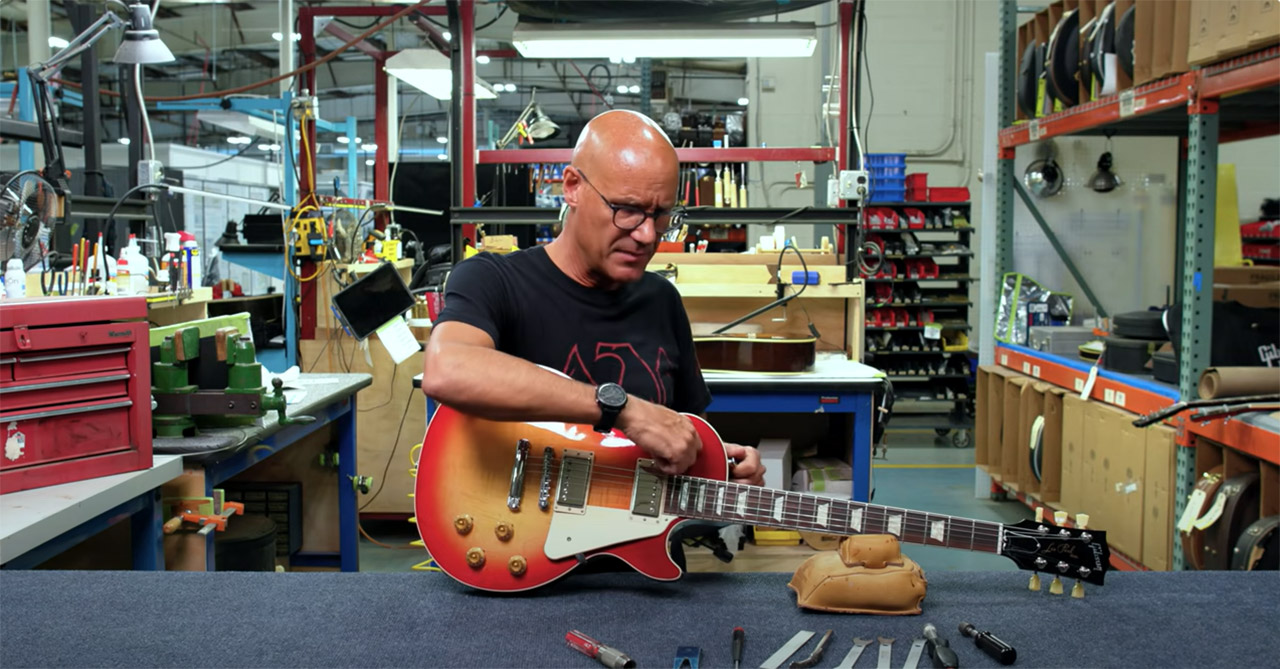Volume and tone knobs are at the heart of dialing in your guitar tone—make sure you know how to keep them well maintained
In this episode of “Gibson’s Guide to Guitar Setup and Maintenance,” Gibson Master Luthier Jim DeCola demonstrates the proper way to tighten loose guitar knobs and controls. Jim’s tips and step-by-step instructions can quickly repair this common issue. Making sure your controls are tightened correctly can reduce the need for future repairs, too.
Most electronic failures are mechanical failures. For example, if the controls rotate too much, they can damage or strain the wires. Controls can also work loose from frequent use, and even expansion and contraction of the wood caused by temperature and humidity fluctuations. These issues can be addressed with a few basic tools and Jim’s expert instructions.
Getting the most from your guitar’s control system for more expression
The volume and tone knobs on an electric guitar are essential tools for shaping your sound and can dramatically affect your overall tone. Understanding and mastering the use of your guitar’s volume and tone controls can greatly expand your tonal palette and enhance your expressiveness as a guitarist. Here are some key points to understand about using these controls:
Volume controls
The volume knob on an electric guitar adjusts its overall output level. If you have two volume controls on a twin-pickup guitar, they will usually control the volume of each pickup independently. Turning the volume up increases the signal strength sent to your amplifier, resulting in a louder sound. Reducing the volume can clean up your tone, which is especially useful when playing through an overdriven or distorted amp setting. The volume control is also a dynamic tool for expressive playing, allowing for swells and fades.
Tone controls
The tone knob modifies the guitar’s treble content. Master tone controls govern the overall sound, but many electric guitars have individual tone controls for each pickup. Turning the tone control down rolls off high frequencies, producing a warmer, softer sound that can be less harsh. This can be particularly effective for creating a smoother sound in jazz or blues, or for thickening up rhythm parts. Adjusting the tone knob enables you to match your sound more closely to the musical context or genre you’re playing in.
Pickup selection interactivity
The impact of volume and tone adjustments can vary depending on your guitar’s pickup selection. Guitars with multiple pickups and a selector switch offer different sound characteristics depending on the pickup configuration, and tweaking the knobs can yield a wide variety of tones. On a twin-humbucker guitar with independent pickup volume controls, one of our favorite tricks is to set the pickup selector in the middle position and roll back a little of the neck pickup’s volume. The result is a very expressive, vocal lead tone that’s also great for filling up frequencies in a power-trio when playing chords.
Controlling feedback with the tone knob
Rolling off some high-end using the tone knob can help control feedback when playing at high volumes, using high levels of gain, or standing close to your amplifier.
Exploring sweet spots
You hear the term “sweet spot” thrown around a lot in guitar media content and on guitar forums but it’s highly subjective and basically just means finding the optimal combination of settings to deliver the best sound for your particular style or song. Experimentation and context are key—try lots of different volume and tone control settings and don’t forget that a guitar tone that may seem thin and scratchy in isolation could be the perfect sound to cut through a dense band mix.
Different settings for different needs
Players in different genres often use their volume and tone controls different. For example, many rock players run everything wide open and stay on the bridge pickup for most of the set because they typically require brighter and more aggressive tones than jazz guitarists. Blues players often use more of the full range of their guitar’s controls—Joe Bonamassa is a master when it comes to using a guitar’s onboard controls to unlock a wide range of sounds.
Interacting with pedals
The settings on your guitar’s volume and tone knobs can affect how your signal interacts with pedals, especially with dynamics-sensitive effects such as wah, overdrive, and fuzz. This interaction offers another layer of tone-shaping beyond the pedal settings themselves.
The Gibson Gazette has a whole section to explore for other repair and maintenance jobs. For support or detailed information on more complicated repairs, be sure to check out Gibson’s free Virtual Guitar Tech service, and if you need replacement parts, check out authentic Gibson hardware.

